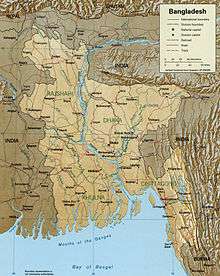Surma River
The Surma River (Bengali: সুরমা নদী, Sylheti: ꠡꠥꠞꠝꠣ ꠘꠖꠤ, romanized: Surma Nadi, Shurma Nodi) is a major river in Bangladesh, part of the Surma-Meghna River System. It starts when the Barak River from northeast India divides at the Bangladesh border into the Surma and the Kushiyara rivers. It ends in Kishoreganj District, above Bhairab Bāzār,[1] where the two rivers rejoin to form the Meghna River. The waters from the river ultimately flow into the Bay of Bengal.

The average depth of river is 282 feet (86 m) and maximum depth is 550 feet (170 m).
Course
From its source in the Manipur Hills near Mao Songsang, the river is known as the Barak River. At the border with Bangladesh, the river divides with the northern branch being called the Surma River and the southern the Kushiyara River. This is where the river enters the Sylhet Depression (or trough) which forms the Surma Basin.[2]
The Surma is fed by tributaries from the Meghalaya Hills to the north, and is also known as the Baulai River after it is joined by the south-flowing Someshwari River.
The Kushiyara receives tributaries from the Sylhet Hills and Tripura Hills to the south, the principal one from the Tripura Hills being the Manu. The Kushiyara is also known as the Kalni River after it is joined by a major offshoot (distributary) from the Surma. When the Surma and the Kushiyara finally rejoin in Kishoreganj District above Bhairab Bazar, the river is known as the Meghna River.
History beside Surma River
From the ancient time, the river Borak finds in many Bangla and Sylheti literature. Historian believes that In ancient Puran described name Suraboti “ꠡꠞꠣꠛꠔꠤ” is Surma. Approximately 1303 CE A Muslim saint, Shaikh al Mushaek Jalal Uddin, popularly known as Shah Jalal, arrived in Sylhet in with 360 companions. A common myth is known by every population of Bangladesh that Shah Jalal across the Surma river by a carpet with 360 companions. In the British pride a bridge built by an English Governor of Assam also the bridge name by his name Keane Bridge “Sir Michael Keane” and it was built in from 1932 to 1937.[1]
Gallery
References
| Wikimedia Commons has media related to Surma River. |
- Bhairab Bāzār (Approved) at GEOnet Names Server, United States National Geospatial-Intelligence Agency
- Mannan, Abdul (2002) "Stratigraphic evolution and geochemistry of the Neogene Surma Group, Surma Basin, Sylhet, Bangladesh" University of Oulu, Oulu, Bangladesh, ISBN 951-42-6710-9
- Niyogi, PK (17 November 2008). "Water, Water everywhere". Travel 8th Day. Kolkata: The Statesman.
There was a motor launch from Mohanganj to Sunamganj. That was a 12-hour journey one-way, cutting right across the haors ... the launch cruised into the Surma River. I looked around and it was water, water everywhere. The river was lost in what the locals called Alir Haor.
External links
- Chowdhury, Masud Hasan (2012). "Surma River". In Islam, Sirajul; Jamal, Ahmed A. (eds.). Banglapedia: National Encyclopedia of Bangladesh (Second ed.). Asiatic Society of Bangladesh.


